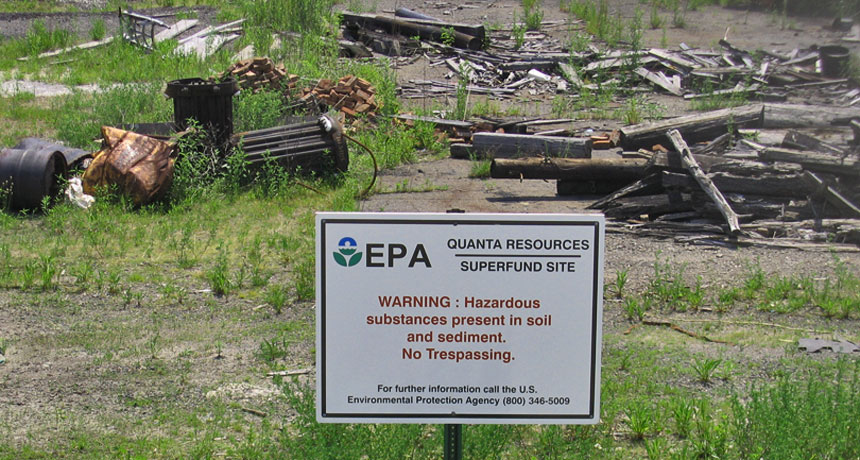Cleaning with greens
Plants may help break down and eliminate toxic wastes

Toxic waste contaminates sites such as this one in Edgewater, N.J. Scientists have now tinkered with the genes in some plants. This allows those greens to help clean up the pollution.
EPA
Toxic chemicals produced by oil spills and air pollution have a new foe: Green plants.
These pollutants often contain a class of chemicals known as polycyclic aromatic hydrocarbons (PAHs). Such chemicals have been linked to many health problems. But researchers now have developed vegetation that can digest PAHs. The plants need some fine-tuning before they’re ready to tackle real-world grime. But the scientists hope their work will lead to a healthier, less costly way to clean up dirt and air.
Cleaning up a contaminated site tends to be quite costly. It often involves digging up the tainted dirt or treating it with expensive chemicals. The United States spends billions of dollars every year on such cleanup efforts. Worldwide, the cost may be about $50 billion. Cleaning up those places with plants, however, could cost far less — perhaps only about one-tenth as much, a team of researchers now estimates.
Bacteria and other microbes can gobble up toxic waste. Scientists have watched them do it at many places around the world. Such organisms digest pollutants and leave harmless substances behind. Engineers have even begun harnessing some of these microbes to help clean up oil spills in seawater, rivers and streams. However, monitoring the progress of these microbes can be difficult. So is finding out how much pollution remains behind.
Quan-Hong Yao is an agricultural scientist at the Shanghai Academy of Agricultural Sciences in China. He and his team developed plants that could do the same thing those microbes do. They used genetic techniques to alter — or engineer — the plants to produce chemicals, called enzymes, that can break down a type of PAH.
Genes influence how an organism looks and behaves. With genetic engineering — also called genetic modification — scientists alter genes. In their new study, scientists used this technique to tweak the function of some plants. Yao’s group added four genes to rice plants and to a small flowering plant called Arabidopsis thaliana the plants. The transferred genes came from a PAH-eating soil microbe, called Pseudomonas putida (SU-duh-MOH-nus PU-tih-da).
And their experiment worked. Once the plants adopted the microbe’s genes, they began producing the microbe’s enzymes.Those enzymes broke down phenanthrene, a type of PAH. After 30 days, the plants removed up to half of the phenanthrene (Fen-AN-threen) in poisoned soil. The researchers reported their results October 9 in Environmental Science & Technology.
These researchers are not the first to have tried to grow plants that could gobble up PAHs. In fact, inserting new genes into a plant isn’t all that difficult. But that solves only part of the problem. If the plant doesn’t make these enzymes in the right way, it won’t digest the pollutants, says Michel Sylvestre. He’s a biochemist at the Centre INRS – Institut Armand-Frappier Research Centre in Laval, Canada. He, too, has tried to grow plants that eat PAHs. But until now, he told Science News, “those who have tried have never succeeded.”
“This is a big deal,” Christopher Reddy adds. He’s an environmental chemist at the Woods Hole Oceanographic Institution, in Massachusetts, who did not work on the new study. Still, he cautions, success in the lab doesn’t prove the plants will work as well in the real world.
“There is still a long way to go” before these gene-altered — or transgenic — plants can be used outdoors, Yao agrees. As a next step, he’ll be testing his plants in real-world situations.
Power Words
Arabidopsis thaliana A weedy mustard plant frequently used to study the growth and behavior of plants. It is so commonly used by plant scientists that it has come to be called the “lab rat” of green-plant studies.
bacterium (plural bacteria) A single-celled organism. These dwell nearly everywhere on Earth, from the bottom of the sea to inside animals.
chemical A substance formed from two or more atoms that unite (become bonded together) in a fixed proportion and structure. For example, water is a chemical made of two hydrogen atoms bonded to one oxygen atom. Its chemical symbol is H2O.
enzymes Molecules made by living things to speed up chemical reactions.
gene (adj. genetic) A segment of DNA that codes, or holds instructions, for producing a protein. Offspring inherit genes from their parents. Genes influence how an organism looks and behaves.
genetic Having to do with chromosomes, DNA and the genes contained within DNA. The field of science dealing with these biological instructions is known as genetics. People who work in this field are geneticists.
genetic engineering The direct manipulation of an organism’s genome. In this process, genes can be removed, disabled so that they no longer function, or added after being taken from other organisms. Genetic engineering can be used to create organisms that produce medicines, or crops that grow better under challenging conditions such as dry weather, hot temperatures or salty soils.
hydrocarbon Any of a range of large molecules created by chemically bound carbon and hydrogen atoms. Crude oil, for example, is a naturally occurring mix of many hydrocarbons.
microbe Short for microorganism.
microorganism A living thing that is too small to see with the unaided eye, including bacteria, some fungi and many other organisms such as amoebas. Most consist of a single cell.
polycyclic aromatic hydrocarbons (or PAHs) A family of combustion byproducts, many of which are quite toxic.
toxic Poisonous or able to harm or kill cells, tissues or whole organisms. The measure of risk posed by such a poison is its toxicity.
transgenic An organism that has had genetic material from an unrelated organism added to it.







